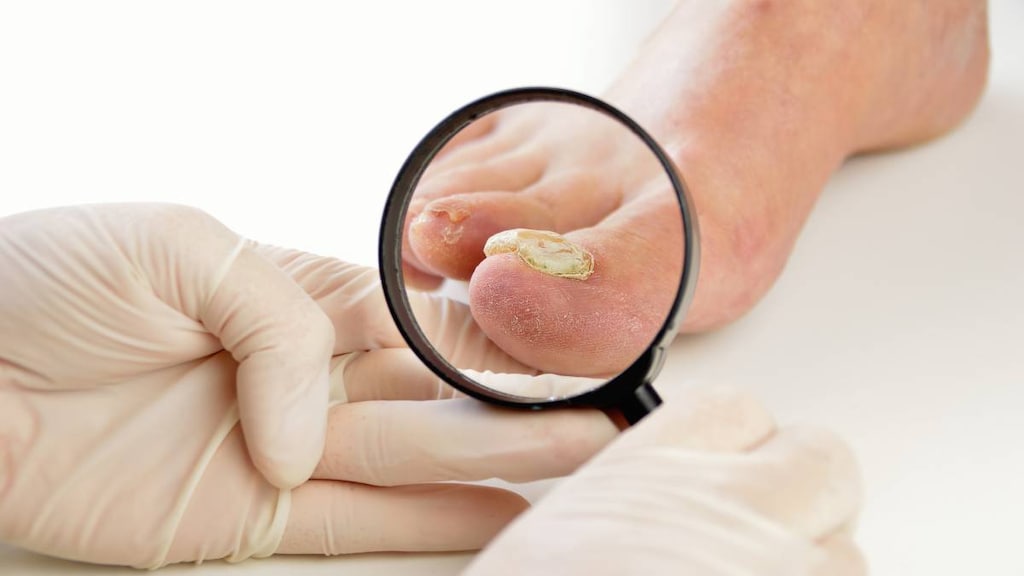Dosage Forms
Excipient information presented when available (limited, particularly for generics); consult specific product labeling.
Solution, External:
Kerydin: 5% (4 mL, 10 mL) [contains edetate calcium disodium, propylene glycol]
Pharmacology
Mechanism of Action
Tavaborole is an oxaborole antifungal that inhibits fungal protein synthesis by inhibition of an aminoacyl-transfer ribonucleic acid (tRNA) synthetase (AARS).
Pharmacokinetics/Pharmacodynamics
Metabolism
Extensive
Excretion
Urine
Use: Labeled Indications
Onychomycosis: Topical treatment of onychomycosis of the toenail(s) due to Trichophyton rubrum and Trichophyton mentagrophytes
Contraindications
There are no contraindications listed in the manufacturer's labeling.
Dosage and Administration
Dosing: Adult
Onychomycosis: Topical: Apply to affected toenail(s) once daily for 48 weeks.
Dosing: Geriatric
Refer to adult dosing.
Dosing: Pediatric
Onychomycosis: Children ≥6 years and Adolescents: Topical: Apply to affected toenail(s) once daily for 48 weeks.
Administration
Topical: Affected toenails should be clean and dry. Apply to completely cover affected toenail surface using provided dropper; also apply under the tip of each affected toenail. Avoid contact with skin other than skin surrounding the treated toenails; wipe away excess solution from surrounding skin and allow solution to dry. Wash hands with soap and water after application.
Storage
Store at 20°C to 25°C (68°F to 77°F); excursions permitted to 15°C to 30°C (59°F to 86°F). Keep away from heat or flame. Discard bottle within 3 months of insertion of the dropper.
Drug Interactions
There are no known significant interactions.
Adverse Reactions
1% to 10%:
Dermatologic: Ingrown nail (3%)
Local: Local skin exfoliation (3%), application site erythema (2%), application-site dermatitis (1%)
<1%, postmarketing, and/or case reports: Allergic contact dermatitis
Warnings/Precautions
Concerns related to adverse events:
- Local irritation: Persistent local irritation, erythema, exfoliation, or dermatitis may develop; instruct the patient to contact their health care provider if this occurs.
Dosage form specific issues:
- Some dosage forms may contain propylene glycol; large amounts are potentially toxic and have been associated with hyperosmolality, lactic acidosis, seizures, and respiratory depression; use caution (AAP 1997; Zar 2007).
Other warnings/precautions:
- Appropriate use: For topical use only; avoid contact with eyes or mucous membranes. Avoid contact with skin (other than skin immediately surrounding treated toenail).
Pregnancy
Pregnancy Considerations
Adverse events were observed in some animal reproduction studies.
Patient Education
- Discuss specific use of drug and side effects with patient as it relates to treatment. (HCAHPS: During this hospital stay, were you given any medicine that you had not taken before? Before giving you any new medicine, how often did hospital staff tell you what the medicine was for? How often did hospital staff describe possible side effects in a way you could understand?)
- Have patient report immediately to prescriber severe application site irritation or ingrown toenail (HCAHPS).
- Educate patient about signs of a significant reaction (eg, wheezing; chest tightness; fever; itching; bad cough; blue skin color; seizures; or swelling of face, lips, tongue, or throat). Note: This is not a comprehensive list of all side effects. Patient should consult prescriber for additional questions.
Intended Use and Disclaimer: Should not be printed and given to patients. This information is intended to serve as a concise initial reference for health care professionals to use when discussing medications with a patient. You must ultimately rely on your own discretion, experience, and judgment in diagnosing, treating, and advising patients.
